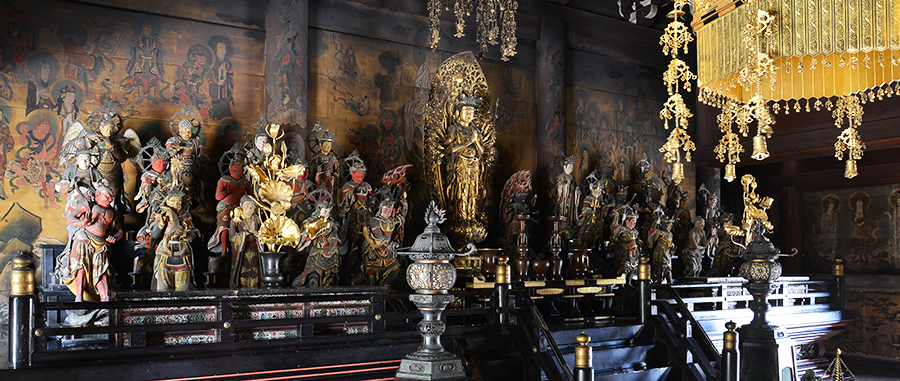行事と境内のご案内
Fukuoji Shrine Autumn Festival
Just west of Ninnaji is Fukuoji Shrine, dedicated to Empress Dowager Hanshi (833–900), the
mother of Emperor Uda (867–931), the founder of Ninnaji. The bond between this mother and
son is celebrated every year on the third Sunday of October during the Fukuoji Shrine Autumn
Festival. An elaborate mikoshi (portable Shinto shrine) believed to contain the spirit of Hanshi is
carried from the shrine through the surrounding neighborhood to Ninnaji. The procession enters
the temple grounds through the Gate of the Guardian Kings, then passes through the
Chokushimon, a gate usually opened only for the emperor’s retinue or his messengers, and stops
in front of the Shinden Hall. A sacred tree branch (tamagushi) believed to be imbued with the
spirit of Hanshi is placed in front of a portrait of Emperor Uda enshrined in the innermost
chamber of the Shinden. This moment is considered the symbolic reunion of mother and son.
The mikoshi is then carried back to Fukuoji Shrine. The rituals of the Autumn Festival serve as a
reminder of how Shinto and Buddhist beliefs and practices were closely intertwined throughout
much of Japanese history.
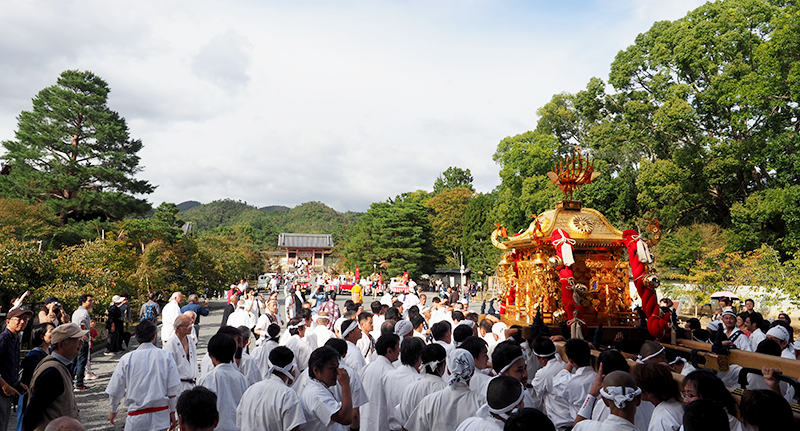
—————————————————————————————————————-
Ninnaji Flower Festival
The grounds of Ninnaji show their most colorful side in spring, when trees and bushes held dear
for centuries by people in Kyoto burst into bloom. The Ninnaji Flower Festival usually takes
place from mid-March to early May and centers on the blossoming of the Omuro Sakura, a
family of cherry trees notable for large flowers with a sweet scent. Planted in hard soil to keep
the trees low—a deliberate aesthetic choice—the Omuro Sakura come in several varieties. The
most common of these is the Omuro Ariake, which produces white, cloud-like blossoms.
Omuro Sakura have been renowned since the Edo period (1603–1868), when Ninnaji first
opened its grounds to the public during cherry-blossom viewing (hanami) season, and they still
attract large crowds every spring. They usually reach full bloom in mid-April, when azaleas add
shades of pink and light purple to the scenery. Toward the end of the festival period, maple trees
provide a bright green backdrop to the flowers. There is a ¥500 admission fee to the temple
grounds during the Flower Festival.
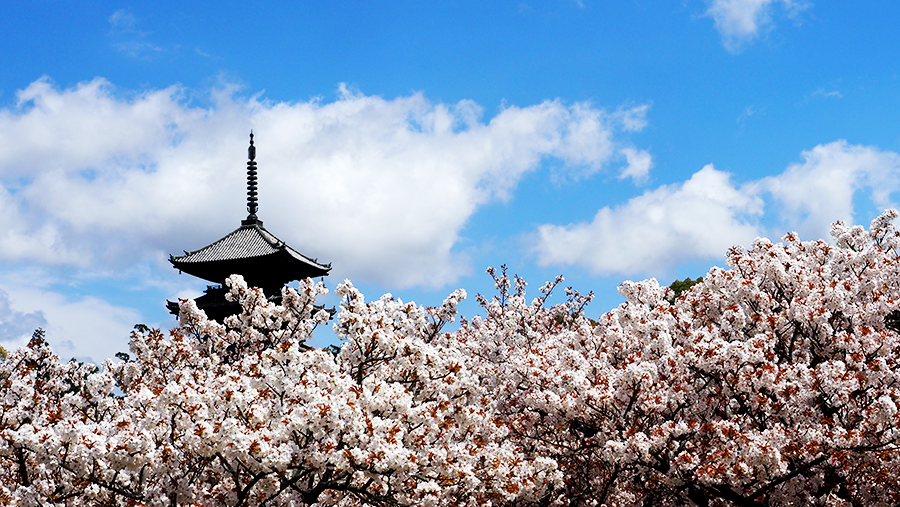
—————————————————————————————————————-
Reihokan Museum
The Reihokan, or Repository of Sacred Treasures, is the main museum at Ninnaji. Located just
east of the central path that leads from the Gate of the Guardian Kings to the Main Hall, it stores
and displays statues of Buddhist deities, paintings, sutra scrolls, letters, and other valuable
artifacts acquired by Ninnaji throughout the temple’s long history. Highlights among these are
statues of an Amida Triad that date back to the temple’s founding in the ninth century, and an
eleventh-century painting of Kujaku Myo-o, the Peacock Wisdom King. Both are designated
National Treasures.
Indicative of Ninnaji’s historical status as an institution closely affiliated with the imperial court
are the many documents hand-written by emperors and addressed to abbots of the temple, a post
held by members of the royal family until 1867. These writings speak especially to the central
role the temple played in the religious life of the Kyoto aristocracy during the Heian period
(794–1185), a time of great cultural flourishing in Japan.
The reinforced-concrete structure evokes ancient Japanese storehouse architecture, and was
designed by architect Kataoka Yasushi (1876–1946). The building was completed in 1927 and is
a registered Tangible Cultural Property. The Reihokan is open to the public during two
semiannual Meiho-ten exhibitions, held for approximately 50 days beginning April 1 and
October 1 every year.
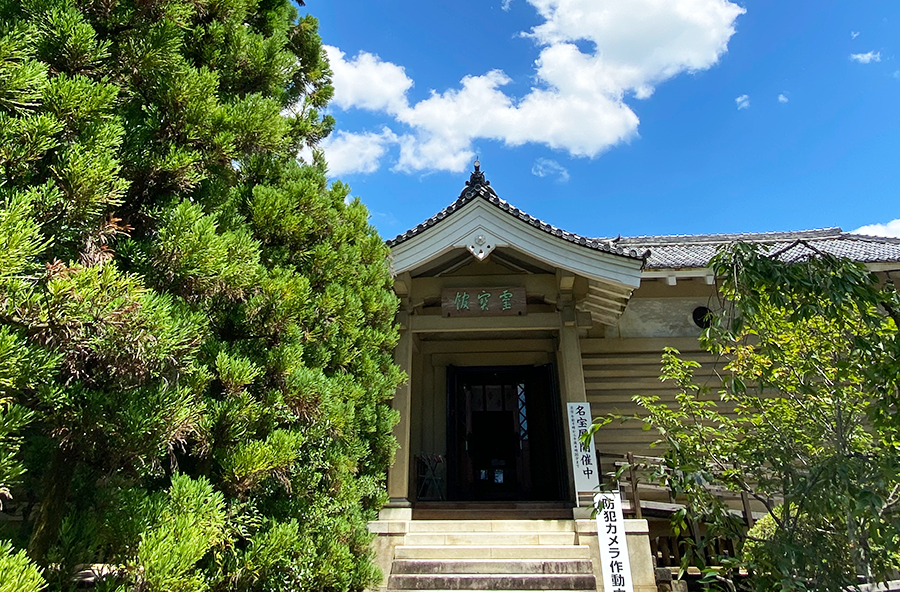
—————————————————————————————————————-
Mizukake Fudo
A small stone statue of Fudo Myo-o, one of the Five Wisdom Kings and a central deity in
Shingon Buddhism, the school to which Ninnaji belongs, is housed within a modest sanctuary at
the very back of the temple grounds. Fudo is believed to protect the faithful and to guide
followers with the fierce love of a parent. He wields a sword in his right hand and a noose in his
left, ready to unleash his anger on demons and other enemies of Buddhism. As is customary for
images of this deity, the statue has a halo of flames and a sturdy rock base, which is said to
represent the determination of Fudo Myo-o (fudo means “immovable”). Mizukake means “to
pour water” and the long ladles placed by the basin are used to pour water over the statue before
saying prayers.
According to legend, the statue was discovered in a flooded Kyoto river sometime during the
Edo period (1603–1868) when a bystander heard it call for help. Once out of the water, the deity
asked to be taken to Ninnaji, where it was placed on a rock next to a spring. The basin in front of
the statue contains water from the same spring.

—————————————————————————————————————-
Sugawara no Michizane’s Rock
At the very back of the Ninnaji grounds is a small sanctuary that enshrines Mizukake Fudo, a
stone statue that worshipers pour water on before offering prayers. The rock that the statue stands
on is said to have once provided a place of rest for a legendary figure in Japanese history.
Sugawara no Michizane (845–903) was an intellectual and bureaucrat who rose to prominence at
court during the reign of Emperor Uda (867–931). After losing a power struggle in 901,
Michizane was sent into de facto exile to Kyushu, the southernmost of Japan’s main islands.
Before departing Kyoto, Michizane visited Ninnaji to say farewell to the retired Emperor Uda,
his former supporter, and now the first abbot of the temple. But the abbot was busy conducting
rituals, and his guest was made to wait and sat on a rock for an entire day. Michizane eventually
left without receiving an audience with the abbot. Michizane died while in exile, and the capital
was soon struck repeatedly by disease and natural disasters. These calamities were attributed to
the vengeful spirit of Michizane, whom the court quickly appeased with the building of a new
shrine, Kitano Tenmangu. Tenmangu shrines, which honor Sugawara no Michizane as the patron
deity of scholarship, are found throughout Japan.
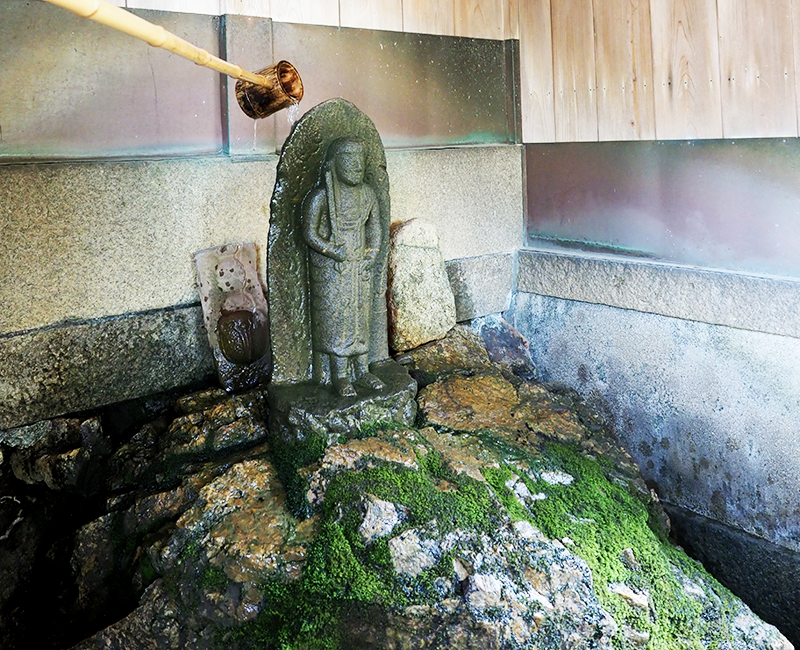
—————————————————————————————————————-
North Garden
The garden on the north side of the Shinden Hall is intended to bring about a sense of calm. This
is achieved with elements such as a spring-fed pond in the shape of the character 心 (kokoro,
meaning heart or mind), a waterfall, and an artificial hill covered with lush foliage. On the hill
stands the Hitotei teahouse, the name referring to the waterfall spray one must pass through to
reach the teahouse. The garden is thought to date to the late 1600s, but it was almost completely
lost in a fire in 1887 that destroyed the Goten Palace. It was rebuilt in its current form in 1914
under the supervision of garden architect Ogawa Jihei VII (1860–1933), who designed several
other notable gardens in Kyoto, including those at Heian Shrine and several private villas near
Nanzenji Temple.
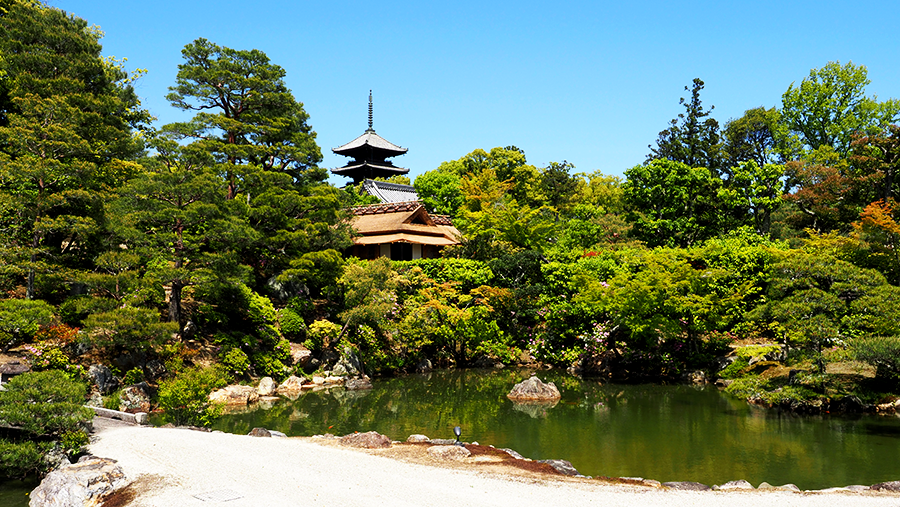
—————————————————————————————————————-
South Garden
The garden on the south side of the Shinden Hall is deliberately simple and is intended to evoke
a sense of solemnity. Cedars and pines provide a backdrop to a rock garden of impeccably raked
white gravel. These stones are from the Shirakawa district in Kyoto and must be washed
regularly to maintain the garden’s intended appearance, as replacement stones are no longer
available. The trees directly in front of the Shinden are a cherry (left) and a mandarin-orange
(right). This combination is considered auspicious and has been associated with the court since
the tenth century, when a cherry tree and a mandarin-orange tree were first planted in front of the
main ceremonial hall at the Kyoto Imperial Palace. The Shinden is surrounded by a veranda that
offers views of both the South Garden and the more elaborate North Garden.
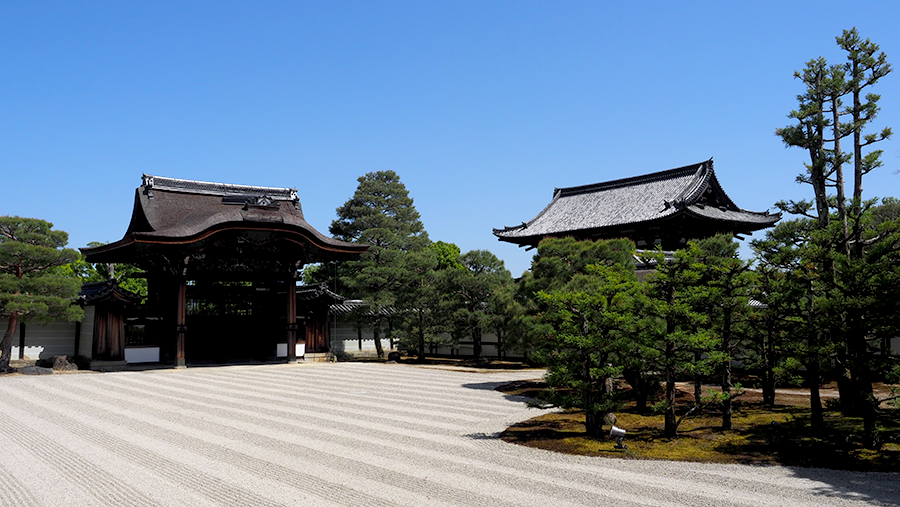
—————————————————————————————————————-
Shorin’an
Shorin’an is the former home of successive generations of samurai who were tasked with serving
and protecting the priests of Ninnaji in the late Edo period (1603–1868). It was donated to the
temple in 1937 by descendants of the family and was moved around several times before being
placed in a tranquil corner of the temple grounds, east of the Gate of the Guardian Kings. A
garden to complement the building was added as part of renovations completed in 2018.
Shorin’an is currently available as luxurious temple lodgings, and groups of up to five can stay
the night for a fee of ¥1 million as part of a private tour of Ninnaji.
The architecture of the renovated building evokes a sense of playfulness. The variably sized
rooms of the two-story structure feature imaginative decor with low doorways and surprising
angles. This peculiar style is particularly evident on the second floor, which includes a small
exhibition room and an equally petite tea room, which can be entered by crossing a miniature
bridge that overlooks the central staircase. The garden in the back is designed to be admired from
the living room on the first floor by opening the sliding shoji doors, but one may also take in the
view while sitting on the veranda that opens onto the garden.
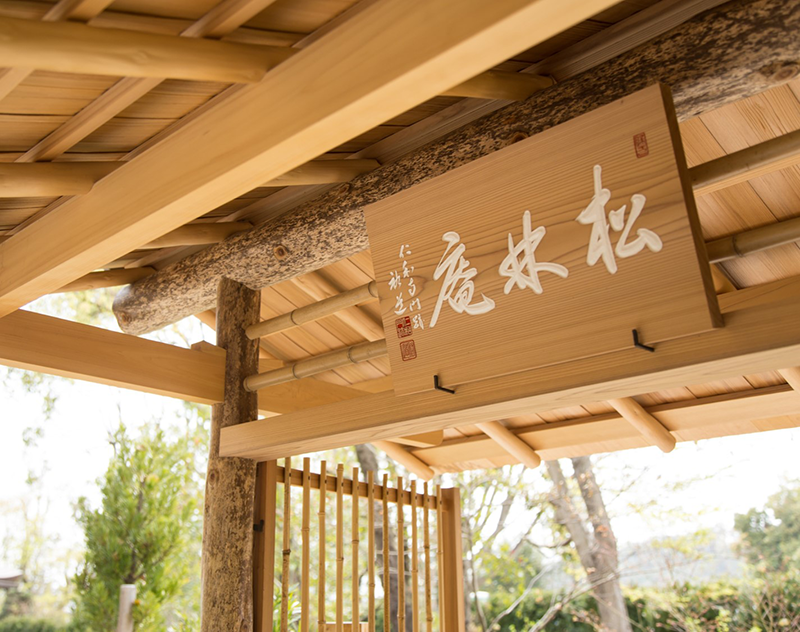
—————————————————————————————————————-
Kusho Myojin Shrine and Lanterns
Kusho Myojin, located near the northeastern end of the Ninnaji grounds, is a Shinto shrine
within a Buddhist temple—a reminder of how these religious traditions were closely intertwined
throughout much of Japanese history. The amalgamation of Shinto and Buddhism endured for
more than a thousand years until 1868, when a series of government orders separated them. This
split, however, was far from absolute, and Shinto shrines often still serve as guardians of
Buddhist temples, as is the case with Kusho Myojin and Ninnaji.
Nine Shinto deities are enshrined in the three buildings of Kusho Myojin: one in the main hall
and four each in the two adjacent halls. All of the deities are also enshrined at major Shinto
shrines elsewhere in Kyoto, and are believed to be gathered at Kusho Myojin to ensure the safety
and prosperity of the imperial court, with which Ninnaji had a special relationship. Ninnaji was
founded by Emperor Uda (867–931), who became the temple’s first abbot after he abdicated the
throne, and held the special status of monzeki temple, a term indicating that its abbots were
princes of royal blood, until 1867. The main hall at Kusho Myojin enshrines Hachiman,
considered to be the deified spirit of Ojin, the fifteenth legendary emperor of Japan, and a
guardian of the imperial family and of warriors.
Three stone lanterns stand in front of the shrine gate. These date back to 1644, the year the
current shrine buildings were completed. The lanterns are in the Oribe style, named after tea
master and lantern designer Furuta Oribe (1544–1615), and are distinguished by the rounded
shape of the upper portions of their pedestals and the jewel-like knobs that crown them.
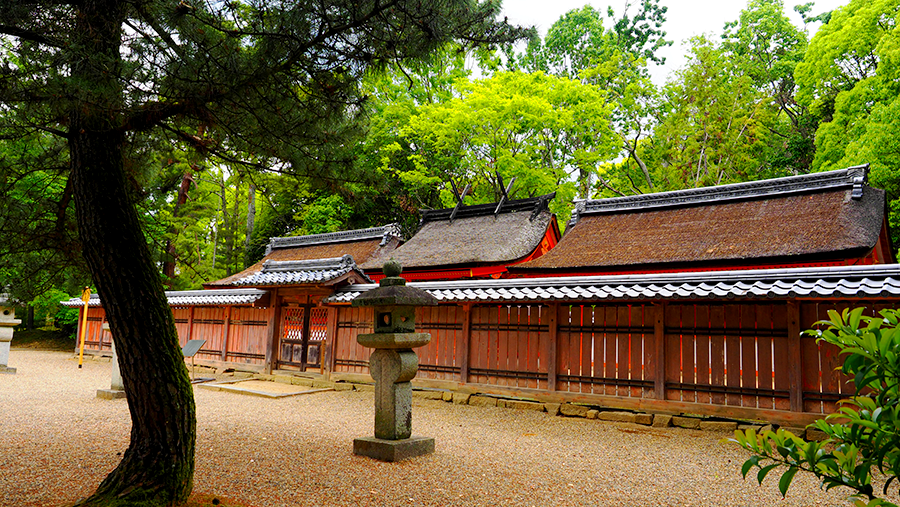
—————————————————————————————————————-
Saijinzuka
Visitors to Ninnaji who step through the Gate of the Guardian Kings and walk toward the Central
Gate are likely to notice a pine-covered mound on their right. This spot honors Saijin
(954–1030), a Buddhist priest who wielded significant religious influence at court during a
period of great cultural flourishing in Kyoto, and who was the teacher of Prince Shoshin
(1005–1085), the second abbot of Ninnaji. Saijin was the son of Minamoto no Masazane
(920–993), a high-ranking nobleman, and a priest of the esoteric Shingon school, one of the two
schools of Buddhism favored by the court and the nobility at the time. He rose through the ranks
of the priesthood, serving in several important positions at Toji, the oldest temple in Kyoto and
Shingon headquarters at the time. Saijin was eventually appointed head of his order, and in 1020
was granted the right—unprecedented for a priest—to enter the inner section of the royal palace
in a cart pulled by oxen, instead of having to leave his cart at the palace gate, as was generally
required. Though the Saijinzuka resembles a burial mound, Saijin’s physical remains are not
thought to be contained within it.
—————————————————————————————————————-
Kannondo Hall VR Experience
The Kannondo Hall features a remarkable collection of Buddhist statues that provide a
comprehensive introduction to Buddhist cosmology. The hall is not open to the public, but its
statues may be viewed up close and in vivid color through virtual-reality tours offered daily at
Ninnaji. Participants are seated in a room decorated with reproductions of paintings displayed
within the Kannondo, and incense is lit in front of them. Using VR headsets, they are led into the
darkness of the virtual hall, where myriad deities stand in formation around a central statue of
Kannon, the bodhisattva of compassion. The statues may be studied in great detail while the
deities and their respective roles and relationships are explained one by one—some with the help
of computer-generated effects. The 13-minute tour is narrated in an uncomplicated and
informative manner in either English, Chinese, Korean, or Japanese.
